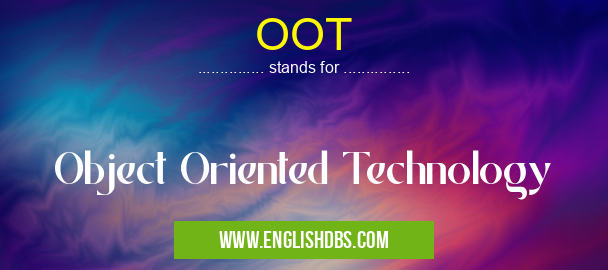What does OOT mean in GENERAL
Object-Oriented Technology (OOT) is a programming paradigm that revolves around the use of objects and classes. This technology allows developers to create software solutions that can be adapted and better suited for the current needs. OOT provides an easier way to organize complex ideas into neat packages or applications, making it easier to review and maintain. It is also beneficial in terms of scalability since changes can easily be made without affecting the existing structure.

OOT meaning in General in Computing
OOT mostly used in an acronym General in Category Computing that means Object Oriented Technology
Shorthand: OOT,
Full Form: Object Oriented Technology
For more information of "Object Oriented Technology", see the section below.
MEANING OF OOT
Object-Oriented Technology is a concept in Computer Science which involves modeling real-world items using computer programs. When an item is modeled with OOT, it is broken down into data sets which represent the object's characteristics, such as its color or size. This data set then forms a template for creating new items which are related to one another in a specific way. For example, if you had an item that was yellow and green, it would inherit from your original template all characteristics related to shades of yellow and green so any new item created using this model would follow this pattern.
ADVANTAGES OF OOT
The primary advantage of OOT is that it helps developers create more efficient software solutions faster. It provides a structured approach so code can be reused easily, allowing for quicker development cycles while keeping code quality high. Additionally, because the objects are separated from each other within the system, it makes it easier to debug tasks when needed and maintain ongoing programs with fewer errors due to its compartmentalized architecture. Furthermore, changes only need to be made in certain areas instead of across the entire program when modifications are necessary - making scalability simpler than traditional approaches where changes must affect the whole system at once.
Essential Questions and Answers on Object Oriented Technology in "COMPUTING»GENERALCOMP"
What is Object Oriented Technology?
Object-oriented technology (OOT) is a programming methodology that uses objects to construct applications and systems. Objects are sets of data and methods that can act on the data. OOT enables developers to create applications quickly, efficiently, and with fewer errors, as compared to traditional programming techniques.
How does OOP work?
In object-oriented programming (OOP), code is organized around objects rather than actions, and data rather than logic. Data and methods are combined together in an object model of the real world. These objects communicate with each other through messages or requests for information from one another. The result is a system of self-contained objects that interact to create a functioning program.
What are the core concepts of OOP?
The core concepts of OOP include abstraction, encapsulation, inheritance, polymorphism, coupling, and cohesion. Abstraction refers to the process of representing an idea using only its essential features; encapsulation means enclosing variables or data in a self-contained unit like an object; inheritance allows new classes to inherit attributes from existing classes; polymorphism allows a function call to provide different behaviors depending on how it’s used; coupling refers to how strongly classes interact with each other; and cohesion measures how well components in a system work together.
Are there benefits to using OOT?
Yes! Benefits of using object-oriented technology include increased flexibility due to reusable code, better organization since all related elements are stored in one place, clearer communication between teams due to standardized terminology associated with objects, more efficient debugging capabilities since errors can be easily spotted due to smaller chunks of code written by individual developers for single tasks assigned within an application’s lifecycle, possibility of rapid prototyping allowing for shorter development cycles for changes or modifications needed after initial release.
How is OOP different from procedural programming?
Object-oriented programming differs from procedural programming in that it relies on objects composed of both data and methods which act on that data while procedural programming relies mainly on functions or procedures acting on global data which may also change based on user input or other events resulting in potential side effects or unexpected results if not monitored closely during development. Additionally, procedural programming is typically more rigid in its design structure whereas object oriented programs have much more flexibility when it comes creating class hierarchies or complex structures like those found frequently when trying model real world systems or processes
Final Words:
Object-Oriented Technology has become widely popular amongst modern day programmers due to its benefits of better organization, readability, maintenance and scalability. This technology allows developers to model real-world items efficiently through templates without having to build entirely new systems from scratch every time they need something altered or updated. As technologies continue forward into increasingly more complex landscapes, Object Oriented Technology will remain a useful resource for developing reliable software solutions.
